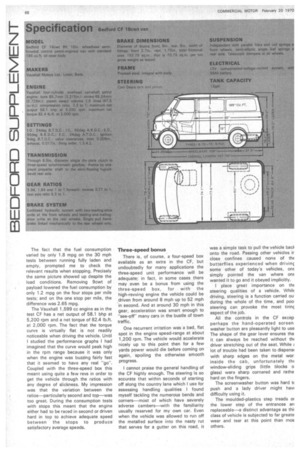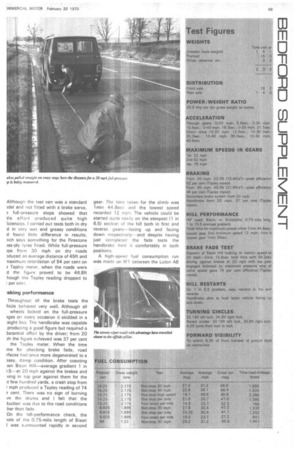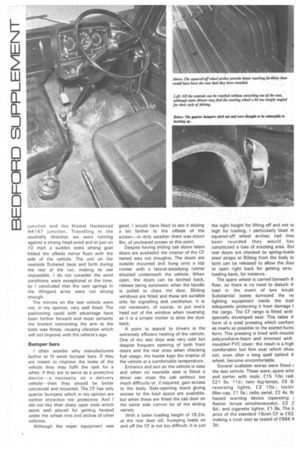The fact that the fuel consumption varied by only 1.8
Page 70

Page 71

Page 72

If you've noticed an error in this article please click here to report it so we can fix it.
mpg on the 30 mph tests between running fully laden and empty, prompted me to check the relevant results when stopping. Precisely the same picture showed up despite the load conditions. Removing 9cwt of payload lowered the fuel consumption by only 1.2 mpg on the four stops per mile tests; and on the one stop per mile, the difference was 2.65 mpg.
The Vauxhall 1,599 cc engine as in the test CF has a net output of 58.1 bhp at 5,200 rpm and a net torque of 82.4 lb.ft. at 2,000 rpm. The fact that the torque curve is virtually flat is not readily noticeable when driving the vehicle. Until I studied the performance graphs I had imagined that the curve would peak high in the rpm range because it was only when the engine was buzzing fairly fast that it seemed to have any real "go". Coupled with the three-speed box this meant using quite a few revs in order to get the vehicle through the ratios with any degree of slickness. My impression was that the variation between the ratios—particularly second and top—was too great. During the consumption tests with stops this meant that the engine either had to be raced in second or driven hard in top to achieve adequate speed between the stops to produce satisfactory average speeds.
Three-speed bonus
There is, of course, a four-speed box available as an extra in the CF, but undoubtedly for many applications the three speed unit performance will be adequate; in fact, in some cases there may even be a bonus from using the three speed box, for with the high-revving engine the vehicle could be ,driven from around 8 mph up to 52 mph in second. And at around 30 mph in this gear, acceleration was smart enough to see-off" many cars in the bustle of town traffic.
One recurrent irritation was a bad, flat spot in the engine speed-range at about 1,200 rpm. The vehicle would accelerate nicely up to this point then for a few yards power would die before coming on again, spoiling the otherwise smooth progress.
I cannot praise the general handling of the CF highly enough. The steering is so accurate that within seconds of starting off along the country lane which I use for assessing handling qualities I found myself tackling the numerous bends and corners—most of which have severely adverse cambers—with the familiarity usually reserved for my own car. Even when the vehicle was allowed to run off the metalled surface into the nasty rut that serves for a gutter on this road, it was a simple task to pull the vehicle badl onto the road. Passing other vehicles ir close confines caused none of thE butterflies experienced when drivinc some other of today's vehicles, onE simply pointed the van where onE wanted it to go and it obeyed implicitly.
I place great importance on thE steering qualities of a vehicle. WhilE driving, steering is a function carried ou during the whole of the time, and pool steering can provoke the most tirin5. aspect of the job.
All the controls in the CF excep perhaps the hand operated screen washer button are pleasantly light to use The shape of the gear lever ensures tha it can always be reached without thr driver stretching out of the seat. While r lot of trouble had been taken to dispensr with sharp edges on the metal wor inside the cab, unfortunately thE window-sliding grips (little blocks o glass) were sharp cornered and rathe hard on the fingers.
The screenwasher button was hard tE push and a lady driver might havi difficulty using it.
The moulded-plastics step treads or the lower step of the entrances an replaceable—a distinct advantage as thi: class of vehicle is subjected to far greate wear and tear at this point than mos others.
Although the test van was a standard )del and not fitted with a brake servo, a full-pressure stops showed that tle effort produced quite high iciencies. I carried out tests both in dry d in very wet and greasy conditions d found little difference in results, lich says something for the Firestone )SS-ply tyres fitted. While full-pressure )ps from 30 mph on dry roads 3duced an average distance of 46ft and -naximum retardation of 94 per cent on a Tapley meter, when the roads were d the figure proved to be 46.8ft hough the Tapley reading dropped to i per cent.
.aking performance Throughout all the brake tests the hide behaved very well. Although all
wheels locked on the full-pressure Nes on every occasion it skidded in a .eight line. The handbrake was capable producing a good figure but required a bstantial effort by the driver; from 20 3h the figure achieved was 37 per cent the Tapley meter. When the time me for checking brake fade, road rfaces had once more degenerated to a easy, damp condition. After coasting wn Bison Hill—average gradient 1 in t.5 at 20 mph against the brakes and ving in top gear against them for the tt few hundred yards, a crash stop from t mph produced a Tapley reading of 74 r cent. There was no sign of burning im the drums and I felt that the fuction was due to the road conditions :her than fade.
On the hill-performance check, the lofe of the 0.75-mile length of Bison I was surmounted rapidly in second gear. The time taken for the climb was 1min 44.8sec and the lowest speed recorded 12 mph. The vehicle could be started quite easily on the steepest CI in 6.5) section of the hill both in first and reverse gears—facing up and facing down respectively and despite having just completed the fade tests the handbrake held it comfortably in both positions.
A high-speed fuel consumption run was made on M.1 between the Luton AS
junction and the Hemel Hemstead A4147 junction. Travelling in the southerly direction we were running against a strong head-wind and at just on 70 mph a sudden extra strong gust folded the offside mirror flush with the side of the vehicle. The unit on the nearside fluttered back and forth during the rest of the run, making its use impossible. I do not consider the wind conditions were exceptional at the time, so I concluded that the cam springs in the Wingard arms were not strong enough, The mirrors on the test vehicle were not, in my opinion, very well fitted. The positioning could with advantage have been further forward and • most certainly the bracket connecting the arm to the body was flimsy, causing vibration which will not improve with the vehicle's age.
Bumper bars
often wonder why manufacturers bother to fit weak bumper bars. If they are meant to improve the looks of the vehicle they may fulfil the task for a while; if they are to serve as a protective device—a necessity on a delivery vehicle—then they should be better conceived and mounted. The CF has only quarter bumpers which in my opinion are neither attractive nor protective. And I did not like their sharp open ends which seem well placed for getting hooked under the wheel rims and arches of other vehicles.
Although the wiper equipment was good, I would have liked to see it wiping a bit farther to the offside of the screen—in dirty weather there was about 9in. of uncleared screen at this point.
Despite having sliding cab doors (slam doors are available) the interior of the CF tested was not draughty. The doors are outside mounted and hung onto a top runner with a lateral-steadying runner situated underneath the vehicle. When open, the doors can be latched back, release being automatic when the handle is pulled to close the door. Sliding windows are fitted and these are suitable only for signalling and ventilation. It is not necessary, of course, to put one's head out of the window when reversing as it is a simple matter to slide the door back.
. A point to appeal to drivers is the extremely efficient heating of the vehicle. One of my test days was very cold but despite frequent opening of both front doors and the rear ones when checking fuel usage, the heater kept the interior of the vehicle at a comfortable temperature.
Entrance and exit on the vehicle is easy and when no nearside seat is fitted a driver can cross the cab without too much difficulty or, if required, gain access to the body. Side-opening doors giving access to the load space are available, but when these are fitted the cab door on the same side cannot be of the sliding variety.
With a laden loading height of 18.2in. at the rear door sill, humping loads on and off the CF is not too difficult. It is just the right height for lifting off and not to high for loading. I particularly liked th squared-off wheel arches; had thes been rounded they would hay constituted a loss of stacking area. Boi rear doors are checked by spring-bade steel straps at 90deg from the body LA both can be released to allow the dooi to open right back for getting onto loading bank, for instance.
The spare wheel is carried beneath tf floor, so there is no need to disturb 0load in the event of tyre troubl, Substantial boxes surround the re; lighting equipment inside the bolt adequately protecting it from damage t the cargo. The CF range is fitted with specially developed seat. This takes th form of a steel pressing which conforrr as nearly as possible to the seated hurnE form. This pressing is lined with mouldE polyurethane-foam and trimmed with moulded PVC cover; the result is a .high comfortable but firm seat which shou not, even after a long spell behind th wheel, become uncomfortable.
Several available extras were fitted c the test vehicle. These were: spare whe and carrier with tools, £15 10s; radi £21 5s. 11d.; twin fog-lamps, £5 5: reversing lights. £3 10s.; lockir filler-cap, £1 5s.; radio aerial, £2 4s. 6c hazard warning device (operating ; flasher lamps simultaneously), £3 2 6d.; and cigarette lighter, £1 8s. The Ii price of the standard 18cwt CF is E63. making a total cost as tested of £686 4 3d.














































































































































































































